Disclaimer: This post contains affiliate links to handpicked partners, including tours, gear and booking sites. If you click through or buy something via one of them, I may receive a small commission. This is at no extra cost to you and allows this site to keep running.
Here are the things to do in Tainan to see it differently – a historical city granted little attention, despite being the oldest city in Taiwan.
Tainan is the oldest city and the first capital of Taiwan. This southwestern coastal city blends a 400-year-old history, from a Dutch colony in 1624 to 1662 to its time under Imperial Chinese rule. Tainan is also known as the city of temples – having more than anywhere else in the country. A city of tradition, ritual and folklore, of which you will only scratch the surface.
An arrangement of sites within a modern metropolis that places it mostly off-radar. Altogether, Tainan is a beautiful sightseeing ground for the hardened traveller who loves to dig a little deeper.
Where modern-day Taiwan springs into life, the spread-out canvas of Tainan can be challenging to grasp at first and may require a little planning. I was lucky enough to live in an apartment run by a local couple, who helped me map out the attractions of Tainan to ensure I covered the most important parts during my short stay. Sites that span three areas – Anping District, Annan District and Taiwan city centre.
Here are the places to visit in Tainan to see it differently and understand its significant cultural and historical placement in the birth of modern Taiwan.
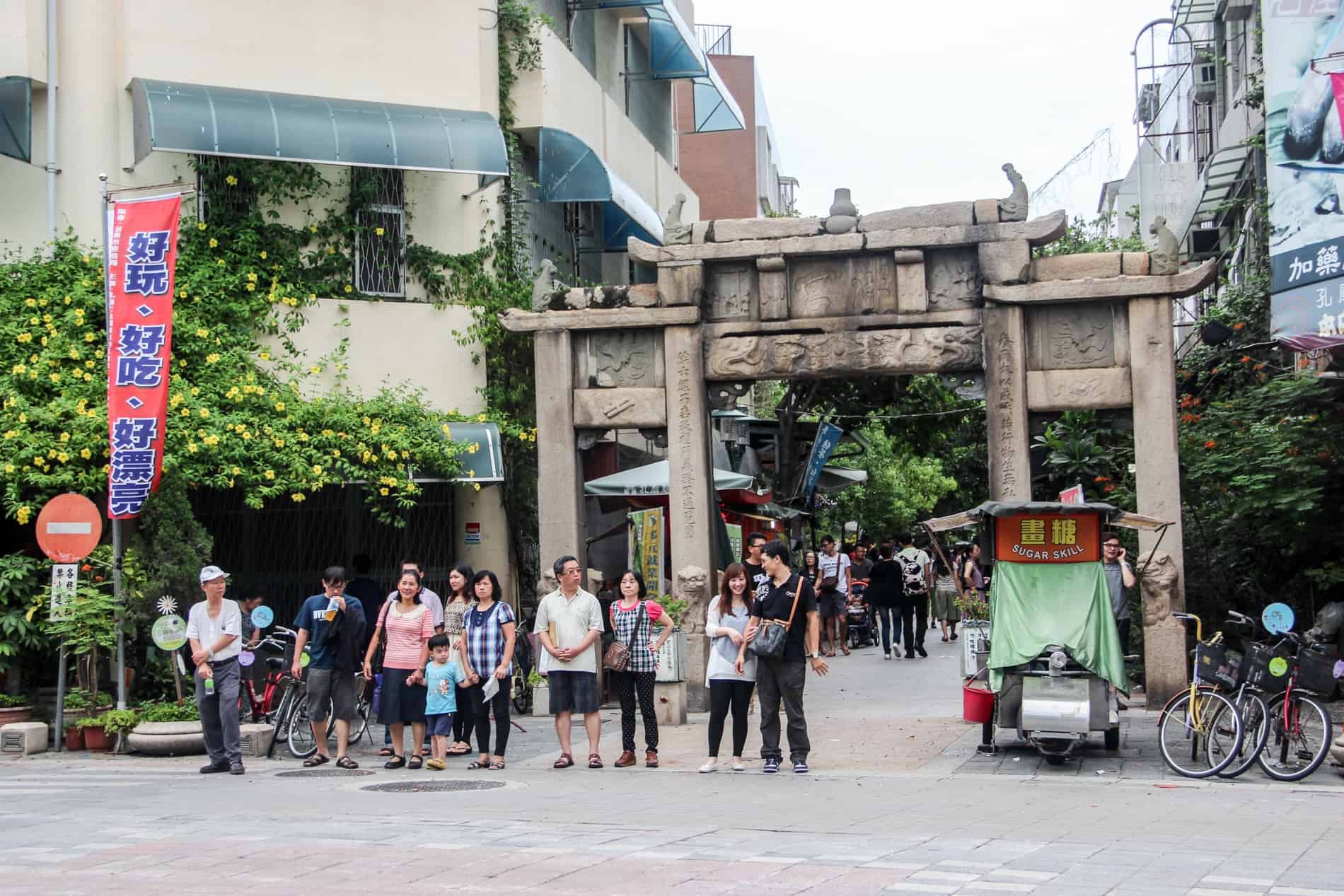
Things to Do in Tainan – See Taiwan’s Oldest City Differently.
Contents
Getting to Tainan
The easiest and quickest way of getting to Tainan is to take the Taiwan High Speed Rail service from Taipei.
With daily schedules, the journey from Taipei to Tainan takes 90 minutes and costs around €30 for a Standard Seat.
Plan and book tickets from Taipei to Tainan via the popular 12Go Asia booking platform.
Planning a Trip around Taiwan
Is Tainan one of many destinations you want to visit in Taiwan? Here’s how to incorporate Tainan with other island highlights.
READ MORE: Places to Visit in Taiwan – The Little Known Island with Big Attraction
Things to Do in Tainan – Historical and Cultural Highlights
What’s Tainan known for? Historical sites spanning the Dutch occupation, the Ming and Qing Dynasties to the Japanese Colonial Period, alongside the continuance of tradition, especially the sacred temples and the beloved night markets.
There are plenty of attractions in Tainan, but they are spread out. The easiest way to navigate it all is to start harbourside in the western Anping District, where you’ll find a cluster of heritage sites, before moving on to the neighbouring Annan District for a stop at one of Tainan’s most renowned and important temples. Then head inland and enjoy Tainan’s modern city centre, finding the historical dynastic-era streets while stumbling upon temples, parks and markets.
Anping District
Anping is a district of Taiwan on a cluster of small islands and harbour peninsulas west of the city centre.
The harbourside site of the original Dutch settlement, Anping’s main attractions are the preserved historical sites, including the 17th-century Dutch era Anping Fort (Fort Zeelanda) and the adjacent historical avenue, Anping Old Street, the Matsu temple, and the Anping Tree House.
Anping Kaitai Tianhou Temple (Matsu Temple)
Also known as Anping Matsu Temple, Anping Kaitai Tianhou Temple is the oldest Matsu temple on the island, granting it historical significance. Located near Anping Fort, the temple was built later during the Qing Dynasty in 1668. It’s dedicated to Matsu (Mazu), Goddess of the Sea and protector of all seafarers, especially Chinese settlers, as they journeyed from the mainland. It’s adorned in intricate carvings, and gilded alters filled with Matzu deities.

Anping Matsu Temple, Tainan.
Fort Zeelandia (Anping Old Fort)
Anping’s history is a layering of colonial and imperial rule. Of control and change. Built by the Dutch East India Company, Fort Zeelandia (also known as Anping Old Fort) served as a stronghold and centre of trade between Europe and Asia. The site was surrendered following the Ming siege in 1661, ending Dutch rule on the island.
The restored fort grounds and museum allow visitors to learn about Dutch occupation history and the foundations of modern Anping.

Visiting Anping Old Fort.

Fort Zeelandia Museum, Anping.
Anping Tree House
A faded, white-washed building with colonial-style arcades housing an exhibition. Behind it the adjoining warehouse building, reclaimed by nature. The site, known as the Anping Tree House, is named for the enormous Banyan tree that has wiggled and weaved itself in a strangling hold across a huge chunk of the former British Tait & Co Merchant House from 1867.

Former Tait & Co Merchant House in Tainan.

One of the quirky things to do in Tainan is to see the Anping Tree House.
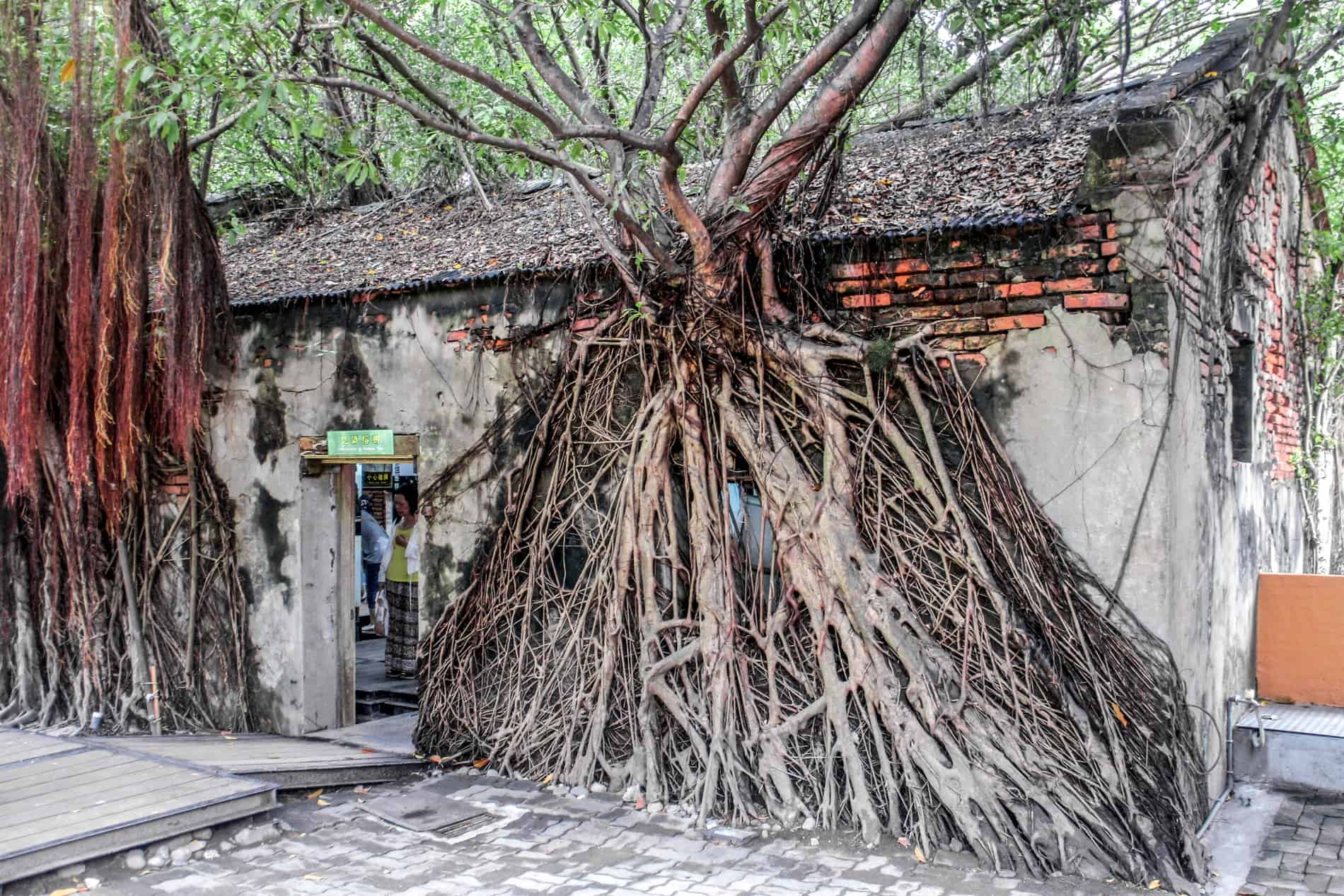
Nature reclaiming an old warehouse of the Former Tait & Co Merchant House.
Anping Old Street (Yanping)
Anping is the area most entrenched in tradition, where secret passageways and narrow streets lead to pockets of local life or traditional landmarks.
I was told to look out for a specific, easy-to-miss street connected to one of the main streets called Yanping. And I’m glad I found it, for this narrow alley led me down a little maze of traditional houses, where local people would welcome your curiosity with a gentle smile. All around town, you will find a whole host of old streets – quiet havens with a mish-mash of crumbling brick lanes, hutong-style settlements, street food stalls and even fairground-style games.

Residential Anping.

Wandering the historical Anping Old Street and side avenues.
Another great way to see the area is to seek out the ‘Sword-Lion’ heads scattered around. With over 30 left in the town, you will find many on outer residential walls and above the door frames.

One of the Sword-Lion heads on Anping Old Street.
Annan District
The Luermen Matsu Temple
This was the day I learned about an important figure in Taiwanese religious culture called Matsu (Mazu), also known as the ‘Goddess of the Sea’ or ‘Sea Mother’. It was following a visit to the Luermen Matsu Temple, which houses a bold, black 800-year-old statue of this principal deity. The temple, built in 1661, is in a village in Tainan’s Annan District, which has great historical meaning for the Taiwanese.
I wasn’t expecting anything remotely different to some of the magnificence I had already seen during my 15 months of various temple hopping. Yet the Luermen Matsu Temple was beautifully dominating, intricate in design and detail and possibly one of the most magnificent Chinese temples I have ever seen.
Legend has it that Matsu raised the seawater to great heights so that the Chinese military ruler, Zheng Chenggong, could land in Taiwan with ease and successfully drive out the Dutch. The temple marks the exact spot where this all happened, thus marking the making of modern Taiwan and why this temple is considered one of the most important in the city.
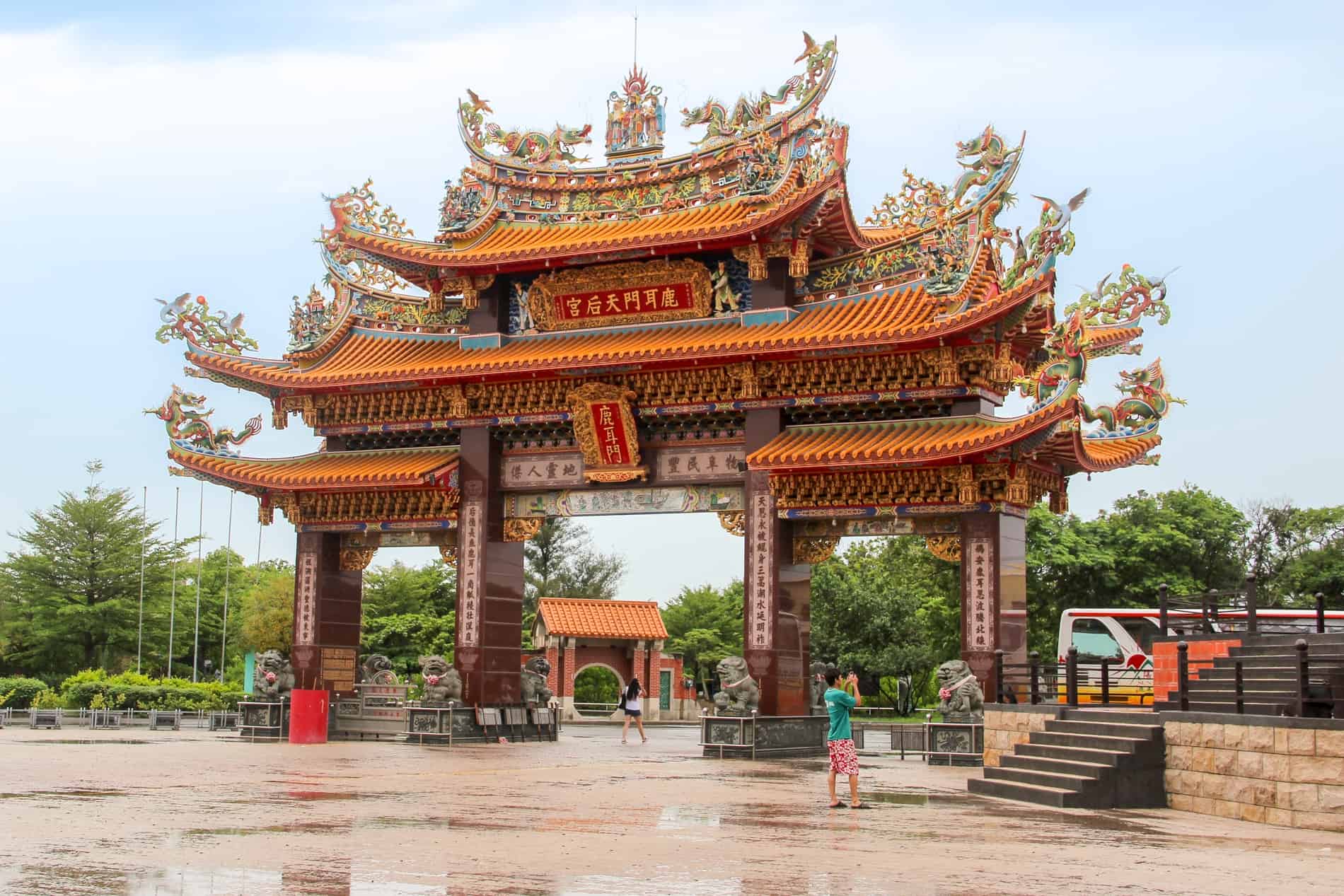
One of the Gates of the Luermen Matsu Temple.

One part of the Luermen Matsu Temple complex.

Inside one section of the vast Luermen Matsu Temple.

One of Tainan’s most beautiful and intricately designed temples.
Just as we were leaving the temple compound, we heard a stir in the air and a rumbling commotion of activity. It was the start of a traditional folk ceremony – a core religious performance that I was very lucky to have stumbled upon. It appeared to be the ‘welcoming back’ ceremony, where Sea Mother’s ‘Deputy Gods’ pilgrimage to the temple so that her power is recharged.
Not only were we watching a show of the Gods, but also the rituals of The Eight Generals’ or the ‘protectors’ of the Gods (known by the distinct face paint), who clear the road of evil spirits as they travel towards the temple. I’ve never seen a temple ceremony so extravagant and elaborate.
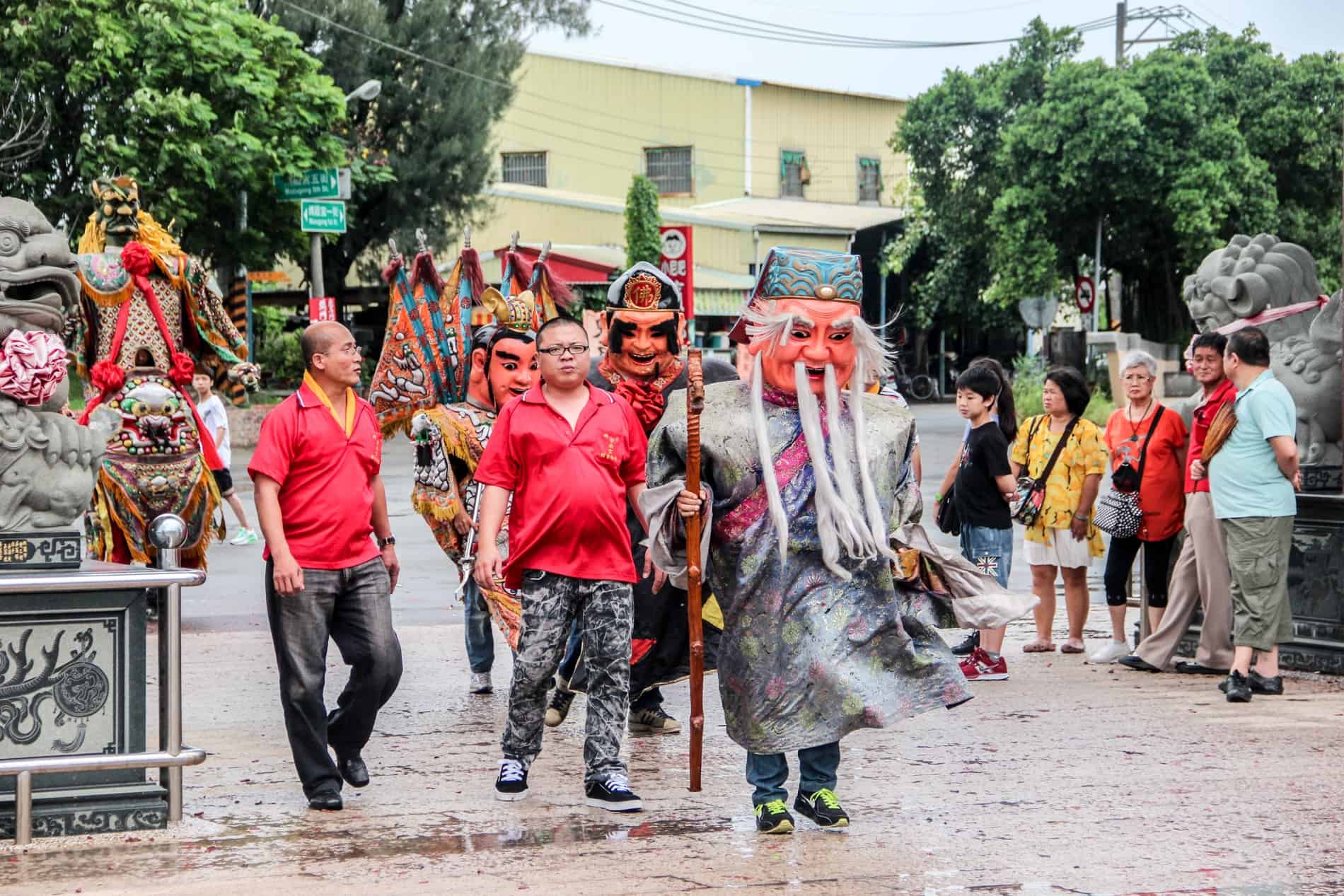
Costume, music and dance – part of a traditional ceremony at the Luermen Matsu Temple.
See Tainan City
The oldest city in Taiwan, yet in parts hard to tell, Tainan City grows on you despite the landscape not being as ancient-looking as one might expect, interspersed with modern stores and coffee houses.

Modern Tainan City.
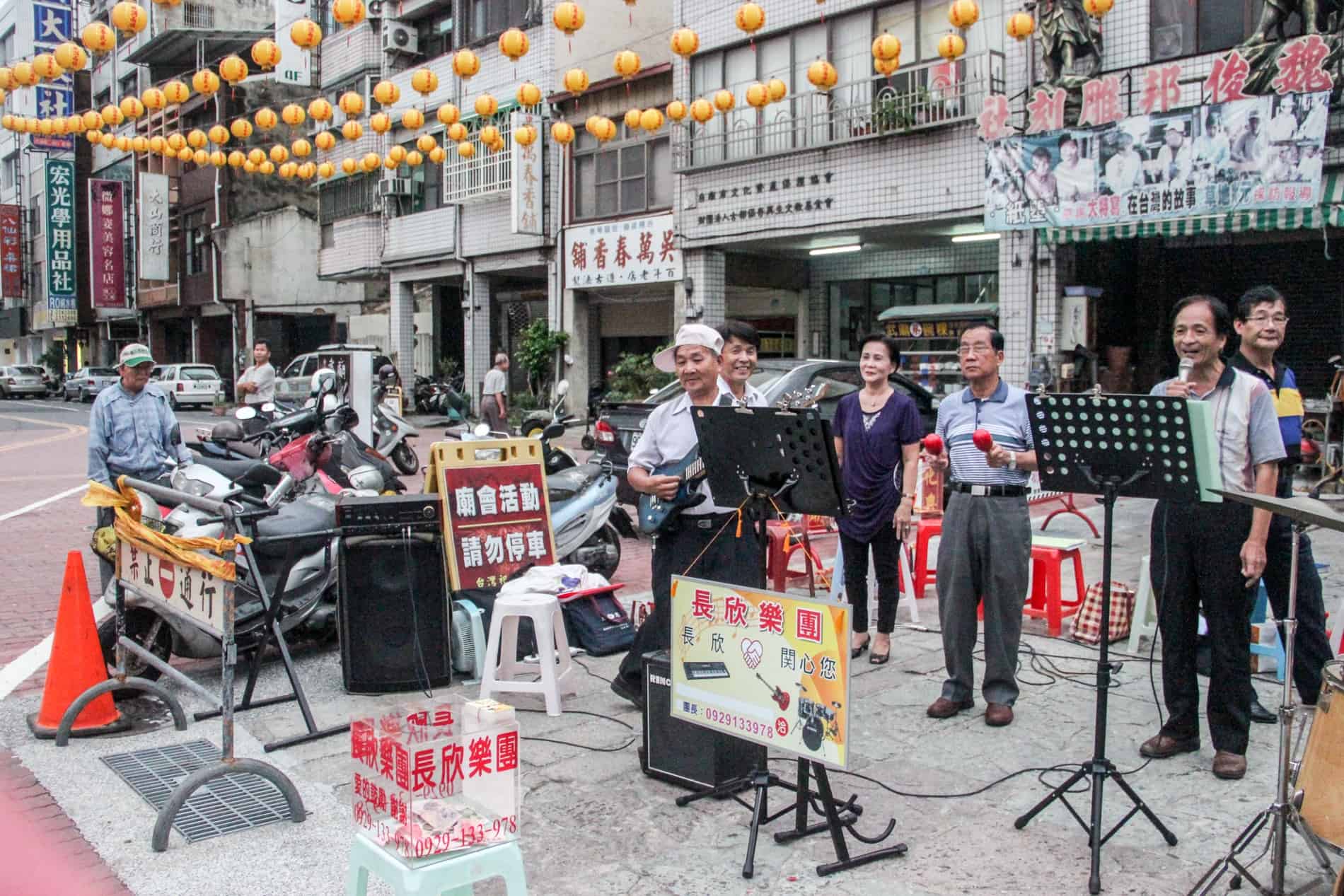
Street music in Tainan.
The Historical Shennong Street
Originally a primary Dutch colony, which later became Taiwan’s first Chinese-ruled capital after their defeat, there is a real mixture of architecture, colour and atmosphere, which changes as you wander through the juxtaposition of historical sites and modern industrial hubs. A mix of grand colonial-style buildings, ancient temples, relics and winding alleyways brimming with old structures peeking among the new.
It may not be blindingly obvious at first sight, but it’s there to find, and the old Shennong Street is the place to start. An avenue of traditional architecture, and restaurants, alongside family-run stores and street vendors selling local handicrafts. It’s also well known as the place to find medicine shops – a continuation of a centuries-old tradition.

Wander the historical streets in Tainan, like old Shennong Street.

Tainan life – finding food vendors in narrow side-streets.

Old streets, old houses, old Tainan.
Temples of Tainan City
With temples in Tainan seemingly around every corner, you might be unsure which ones to put at the top of your sightseeing list. Aside from those already mentioned in other districts, the core city centre Tainan temples include:
- Tainan Confucius Temple – in dedication to the Chinese philosopher and teacher, Confucious. It is considered the first and most important of Taiwan’s Confucious temples.
- Xishe Xilong Temple – dedicated to Chi Fu Qian Sui, protecting those who go to sea.
- Tainan Koxinga Temple – a park-set temple for Ming General Koxinga, with historical exhibits.
- Tainan Grand Matsu Temple – the central city’s renowned Sea Goddess temple, built in 1684.
- Tainan City God Temple – dedicated to the city god of Tainan, Chenghuang.
- Tainan Wufei Temple / Temple of the Five Concubines – dedicated to the five concubines of the Ming Dynasty Prince Zhu Shi-Gui.
- Tainan Guan Yu Temple – dedicated to the God of War, known as Guan Gong or Guan Yu.

The Tainan Confucius Temple.

Xishe Xilong Temple in Tainan.
Heritage Buildings
The city is laced with repurposed heritage structures, such as the Tainan Wude Hall, the former Old Martial Arts Hall, and the colonial old court house, now Tainan City Council History Museum.

Tainan Wude Hall – Old Martial Arts Hall.

Tainan City Council History Museum.
Tainan Night Markets
The Taiwanese proudly boast about their night markets – a sensory overload you MUST experience. They are everywhere, in almost every key town and city and a place where you eat, drink, play and socialize, not just shop.
The main night markets in Tainan are the Garden Night Market (the largest), Wusheng Night Market, and Xiaobei Chenggong. Collectively, these markets are said to be the biggest outside of Taipei. They are within walking distance of each other in the centre of Tainan city if you want to hop from one to the other.
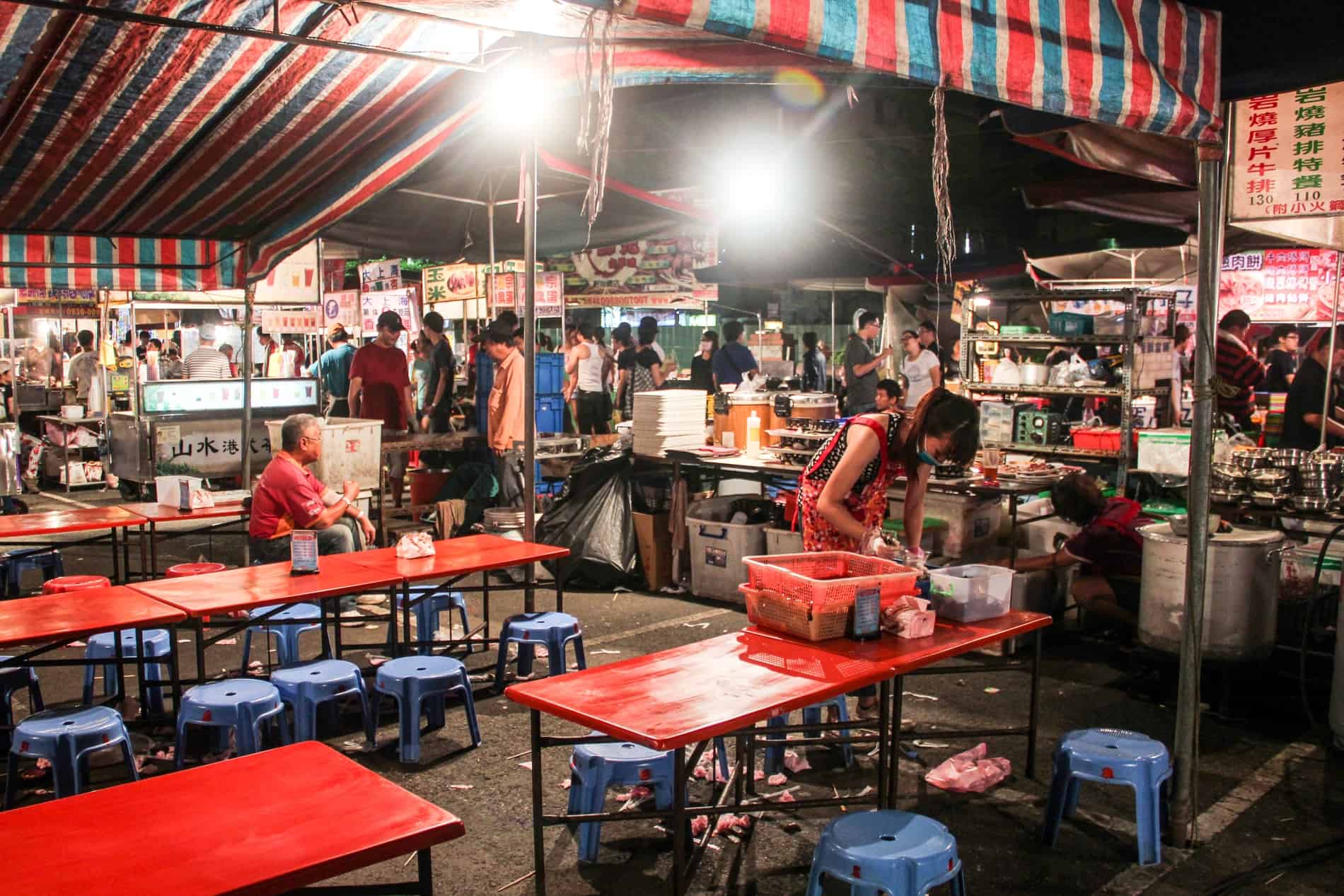
One of the best things to do in Tainan is to enjoy the atmosphere of the Night Market.
I love the buzzing, chaotic atmosphere of night markets – an ancient Chinese tradition. The sizzling sounds and the wafting smell of street food, the hum of excitement as people hang out on the street or huddle around small tables sitting on low stalls. It’s a wrap of community, friendship and fun.
Guided by my new-found local friends, we ate sweet potato cake and ice cream, skipped the stinky tofu and intestines, and bartered for Hello Kitty phone covers, laptop cases and clothes.

Tainan Night Market BBQ.
One interesting thing I learnt was that it’s OK to drop litter on the ground within the market. When my local friend told me to do so, I looked at her in shock – people are given the job of cleaning everything up. Quote the cultural shock considering that dropping litter is a huge cultural taboo in the west.

Rows of stalls at Tainan’s Night Markets.
Why You Should Visit Tainan and Live Locally
Tainan is a treasure trove of history combined with the comfort of modern amenities. Easy to reach by the standard and high-speed (HSR) rail system, it’s a great area of the country to get to grips with the traditional folk culture, which still plays a big part in today’s society, as well as see old Taiwan in its natural state.
Booking a Tainan Homestay
Thomas and Abby run At Home – a modern apartment with three rooms located within a residential area not far from Tainan’s railway station. It was a wedding gift from their parents. Instead of living there, they chose to stay with their family, as is tradition, and utilise their love of travel and knowledge of the area by running a guesthouse to help others enjoy and learn about this historical city.
Abby told me that she and Thomas are now training to become licensed tour guides – a skill they have in their possession naturally. If you are looking for a homestay experience combined with the convenience of local expertise and one-on-one guidance, I couldn’t recommend these incredibly welcoming and selfless people more.


Steph says
Tainan was the surprise breakout hit from our 3 weeks spent traveling throughout Taiwan. I loved the mix of old and new and how much history is crammed into every part of the city. It was the perfect place to just wander and get lost down the little alleyways; I always felt that around every corner I was stumbling upon a wonderful story that needed to be told or a picture that needed to be captured. I’m glad to see you enjoyed your time there too!